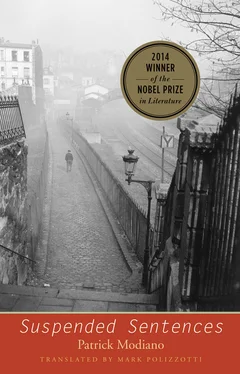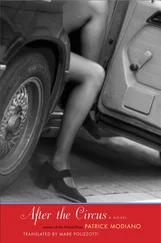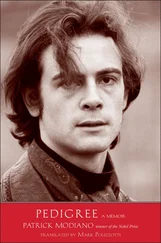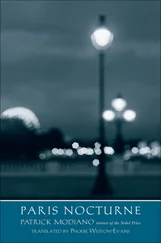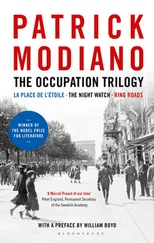It didn’t take me long to realize he wasn’t telling the whole truth: about that “large textile concern,” he remained vague. And he contradicted himself, telling me one day that he’d graduated from Saint-Maixent, just before his departure for Algeria, then the next day that he’d done all his schooling in England. Sometimes his plummy dental accent yielded to a street hawker’s patter.
It was only because I was walking in Montparnasse that Sunday evening that Duvelz — or Devez — suddenly reemerged from the void. I remembered that one day, we had run into each other on Rue de Rennes, and he had invited me for a stein of beer, as he said, at one of those dismal cafés in Place Saint-Placide.
The Cabaret des Isles on Rue Vavin, where the couple had allegedly been spotted, occupied the basement of Les Vikings. The Scandinavian ambiance and light-colored wood of Les Vikings clashed with the Negro cabaret. You just had to go downstairs: from the Norwegian cocktails and hors-d’oeuvres of the ground floor, you were plunged into the frenzy of Martinican dances. Is that where the T.’s met the two women? I suspect it was instead at the Café de la Marine on Boulevard Raspail, near Denfert-Rochereau. I remember the apartment where Duvelz had dragged Jacqueline and me, at one end of that same Boulevard Raspail. I hadn’t dared refuse his invitation that time, either. For nearly a week, he had insisted that the two of us come on Saturday evening to visit a woman friend of his that he absolutely wanted us to meet.
She opened the door and, in the half-light of the vestibule, I couldn’t quite make out her face. I was struck by the opulence of the large living room we entered, so out of character with Duvelz’s small hotel room on Rue Delambre. He was there. He introduced us. I’ve forgotten her name: a brunette with regular features. One of her cheeks bore a large scar, near the cheekbone.
Jacqueline and I were sitting on the sofa. Duvelz and the woman, on armchairs, facing us. She must have been about Duvelz’s age: thirty-five. She looked at us with curiosity.
“Don’t you find the two of them charming?” said Duvelz in his dental accent.
She stared fixedly at us. She asked:
“Would you like something to drink?”
Things felt awkward. She served some port.
Duvelz took a large sip.
“Relax,” he said. “She’s an old friend …”
She gave us a shy smile.
“We were even engaged once. But she had to marry someone else …”
She didn’t react. She sat very straight in her chair, her glass in her hand.
“Her husband is often away. We can take advantage to go out, just the four of us. What do you say?”
“Go out where?” asked Jacqueline.
“Wherever you like. Or we don’t have to go out at all.”
He shrugged.
“We’re perfectly comfortable here … No?”
She still sat very stiffly in her chair. She lit a cigarette, perhaps to hide her nervousness. Duvelz swallowed another gulp of port. He put his glass down on the coffee table. He stood up and walked over to her.
“She’s pretty, don’t you think?”
He ran his index finger over the scar on her cheek. Then he undid her blouse and began fondling her breasts. She didn’t react.
“We were in a very serious car accident together, back in the day,” he said.
She pushed his hand away gruffly. She smiled at us again.
“You must be hungry …”
She had a husky voice and, I thought, a slight accent.
“Will you help me bring dinner in?” she asked him curtly.
“Of course.”
The two of them got up.
“It’s a cold supper,” she said. “Will that be all right?”
“That’s perfect,” said Jacqueline.
He had taken the woman by the shoulder and steered her out of the living room. He stuck his head through the doorway.
“You like champagne?”
He had lost his dental accent.
“Very much,” said Jacqueline.
“Be right back.”
We sat alone in the living room for a few minutes, and I’m racking my brains to remember as many details as I can. The French windows looking out on the boulevard were half-open because of the heat. It was at 19 Boulevard Raspail. In 1965. A grand piano at the very back of the room. The sofa and the two armchairs were made of the same black leather. The coffee table of chrome-plated metal. A name like Devez or Duvelz. The scar on the cheek. The unbuttoned blouse. A very bright light, as if from a projector, or rather a flashlight. It lights only a portion of the scene, an isolated instant, leaving the rest in shadow. We will never know what happened next or who those two people really were.
We slipped out of the living room and, without shutting the door behind us, crept down the stairs. Earlier, we had taken the elevator, but it wasn’t red like the one mentioned by Gisèle T.
A statement by a waiter who worked in a restaurant-nightclub in Le Perreux figures on the front page of an evening paper in that month of April 1933. The headline is as follows:
POLICE SEARCHING FOR TWO COUPLES
WHO SPENT EVENING IN APARTMENT
OF YOUNG CHEMIST AND HIS WIFE
At police headquarters in the Val-de-Grâce precinct, though the investigation has been called off because it was ruled a double suicide, they tell us that the young couple had gone not only to Montparnasse but also to the banks of the Marne, to Le Perreux; and that they went not just with two women but with two women and two men…. Attempts to locate these four individuals have so far been in vain.
We went to Le Perreux in hopes of gleaning a few important details on the moments preceding the tragedy.
In a “restaurant-nightclub” on the Quai de l’Artois, they clearly remember the presence of the two young persons.
“They arrived at around ten,” states the waiter who served them. “They were alone. She was very pretty, blonde, very slim … They were sitting over there, under the balcony. Is that where they met the people they invited home? I didn’t notice. We get a lot of traffic on Saturday nights at that time of year. They didn’t seem to be having an especially good time. In any case, I remember they settled their check at eleven-thirty.”
It is hard to take this testimony at face value, as it presupposes that the T.’s had gone to Le Perreux alone, and of their own accord. But everything we know about their life in the quiet neighborhood around Rue des Fossés-Saint-Jacques suggests that they were not the type to frequent dance halls on the banks of the Marne on Saturday nights. No, it was certainly the two unknown women, met in Montparnasse, who took them to Le Perreux that night, as Gisèle T. had herself indicated. And one has to wonder why the waiter made such a statement. Did he confuse them with other customers? More likely, he was trying to steer the investigators away from the people in whose company he had seen the T.’s, two women and two men, no doubt regulars of the establishment. The two women from Montparnasse knew the two men. But where — asked the newspaper article — was the house with the red elevator that Gisèle T. had spoken of?
Leaving the Café de la Marine, the T.’s and the two unknown women might have taken a taxi. But no cab driver, the day after the tragedy, told investigators that he’d driven four fares to Le Perreux-sur-Marne. Nor had a single one come forward to say that he’d brought back several couples from Le Perreux to number 26 Rue des Fossés-Saint-Jacques at around two in the morning.
In those days, one went from Paris to Nogent-sur-Marne and Le Perreux via the train station at Bastille or the Gare de l’Est. The trains leaving from Bastille followed the so-called Vincennes line, up to Verneuil-L’Etang. I knew that line even in the early sixties, before the RER replaced it and the Bastille train station was demolished to make way for the new Opera.
Читать дальше
